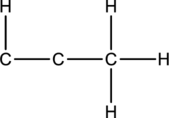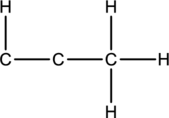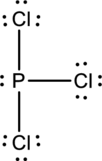
Concept explainers
(a)
Interpretation:
Lewis structure has to be completed from the skeletal structure given below and the bond angles around the central atoms in the given structure have to be predicted using the VSEPR model.

Concept Introduction:
Lewis structure is used for predicting the shape of molecules. From the steric number obtained in a Lewis structure, the molecular geometry can be predicted. VSEPR model can predict the shape of molecules considering their Lewis structure. Certain rules has to be followed in for the VSEPR model.
- The molecule will have a shape where there is minimal electrostatic repulsion between the valence‑shell electron pairs.
- The forces of repulsion between two lone pairs of electrons will be higher than the repulsion between lone pair and bond pair of electrons. This in turn will be higher than the bond pair‑bond pair of electrons.
(a)
Explanation of Solution
Skeletal structure for the molecule given is shown;

The Lewis structure can be drawn considering the valence electrons in the molecule. Total number of valence electrons is calculated as shown below;
Eighteen electrons are used up in the skeletal structure. One electron pair is added to the terminal carbon atom each. Thus the Lewis structure can be drawn as follows;

Bond Angles:
Central atoms present in the above structure are four carbon atoms. The bond angles can be predicted using the steric number.
Steric number for carbon atom C-1:
The number of lone pair of electrons on carbon atom is zero while the number of atoms that are bonded to carbon is three. Therefore, steric number can be calculated as shown below;
As the steric number is three, the arrangement is trigonal planar and the bond angle will be
Steric number for carbon atom C-2:
The number of lone pair of electrons on carbon atom is zero while the number of atoms that are bonded to carbon is three. Therefore, steric number can be calculated as shown below;
As the steric number is three, the arrangement is trigonal planar and the bond angle will be
Steric number for carbon atom C-3:
The number of lone pair of electrons on carbon atom is zero while the number of atoms that are bonded to carbon is three. Therefore, steric number can be calculated as shown below;
As the steric number is three, the arrangement is trigonal planar and the bond angle will be
Steric number for carbon atom C-4:
The number of lone pair of electrons on carbon atom is zero while the number of atoms that are bonded to carbon is three. Therefore, steric number can be calculated as shown below;
As the steric number is three, the arrangement is trigonal planar and the bond angle will be
(b)
Interpretation:
Lewis structure has to be completed from the skeletal structure given below and the bond angles around the central atoms in the given structure have to be predicted using the VSEPR model.

Concept Introduction:
Refer part (a).
(b)
Explanation of Solution
Skeletal structure for the molecule given is shown;

The Lewis structure can be drawn considering the valence electrons in the molecule. Total number of valence electrons is calculated as shown below;
Twelve electrons are used up in the skeletal structure. Two carbon atoms are added with a lone pair of electrons. Thus the Lewis structure can be drawn as follows;

Bond Angles:
Central atoms present in the above structure are three carbon atoms. The bond angles can be predicted using the steric number.
Steric number for carbon atom C-1:
The number of lone pair of electrons on carbon atom is zero while the number of atoms that are bonded to carbon is two. Therefore, steric number can be calculated as shown below;
As the steric number is two, the arrangement is linear and the bond angle will be
Steric number for carbon atom C-2:
The number of lone pair of electrons on carbon atom is zero while the number of atoms that are bonded to carbon is two. Therefore, steric number can be calculated as shown below;
As the steric number is two, the arrangement is linear and the bond angle will be
Steric number for carbon atom C-3:
The number of lone pair of electrons on carbon atom is zero while the number of atoms that are bonded to carbon is four. Therefore, steric number can be calculated as shown below;
As the steric number is four, the arrangement is tetrahedral and the bond angle will be
(c)
Interpretation:
Lewis structure has to be completed from the skeletal structure given below and the bond angles around the central atoms in the given structure have to be predicted using the VSEPR model.

Concept Introduction:
Refer part (a).
(c)
Explanation of Solution
Skeletal structure for the molecule given is shown;

The Lewis structure can be drawn considering the valence electrons in the molecule. Total number of valence electrons is calculated as shown below;
Six electrons are used up in the skeletal structure. Three lone pair of electrons are placed on the chlorine atom each and a lone pair of electron is placed over the phosphorus atom. Thus the Lewis structure can be drawn as follows;

Bond Angles:
Central atom present in the above structure is a phosphorus. The bond angles can be predicted using the steric number.
Steric number for phosphorus:
The number of lone pair of electrons on phosphorus atom is one while the number of atoms that are bonded to phosphorus is three. Therefore, steric number can be calculated as shown below;
As the steric number is four, the arrangement is tetrahedral and the bond angle will be
Want to see more full solutions like this?
Chapter 10 Solutions
Chemistry Principles And Practice
- Identify and provide an explanation of what 'Seperation Science' is. Also describe its importance with the respect to the chemical analysis of food. Provide specific examples.arrow_forward5. Propose a Synthesis for the molecule below. You may use any starting materials containing 6 carbons or less (reagents that aren't incorporated into the final molecule such as PhзP do not count towards this total, and the starting material can have whatever non-carbon functional groups you want), and any of the reactions you have learned so far in organic chemistry I, II, and III. Your final answer should show each step separately, with intermediates and conditions clearly drawn. H3C CH3arrow_forwardState the name and condensed formula of isooxazole obtained by reacting acetylacetone and hydroxylamine.arrow_forward
- State the name and condensed formula of the isothiazole obtained by reacting acetylacetone and thiosemicarbazide.arrow_forwardProvide the semi-developed formula of isooxazole obtained by reacting acetylacetone and hydroxylamine.arrow_forwardGiven a 1,3-dicarbonyl compound (R1-CO-CH2-CO-R2), indicate the formula of the compound obtaineda) if I add hydroxylamine (NH2OH) to give an isooxazole.b) if I add thiosemicarbazide (NH2-CO-NH-NH2) to give an isothiazole.arrow_forward
- An orange laser has a wavelength of 610 nm. What is the energy of this light?arrow_forwardThe molar absorptivity of a protein in water at 280 nm can be estimated within ~5-10% from its content of the amino acids tyrosine and tryptophan and from the number of disulfide linkages (R-S-S-R) between cysteine residues: Ε280 nm (M-1 cm-1) ≈ 5500 nTrp + 1490 nTyr + 125 nS-S where nTrp is the number of tryptophans, nTyr is the number of tyrosines, and nS-S is the number of disulfide linkages. The protein human serum transferrin has 678 amino acids including 8 tryptophans, 26 tyrosines, and 19 disulfide linkages. The molecular mass of the most dominant for is 79550. Predict the molar absorptivity of transferrin. Predict the absorbance of a solution that’s 1.000 g/L transferrin in a 1.000-cm-pathlength cuvet. Estimate the g/L of a transferrin solution with an absorbance of 1.50 at 280 nm.arrow_forwardIn GC, what order will the following molecules elute from the column? CH3OCH3, CH3CH2OH, C3H8, C4H10arrow_forward
- Beer’s Law is A = εbc, where A is absorbance, ε is the molar absorptivity (which is specific to the compound and wavelength in the measurement), and c is concentration. The absorbance of a 2.31 × 10-5 M solution of a compound is 0.822 at a wavelength of 266 nm in a 1.00-cm cell. Calculate the molar absorptivity at 266 nm.arrow_forwardHow to calculate % of unknown solution using line of best fit y=0.1227x + 0.0292 (y=2.244)arrow_forwardGiven a 1,3-dicarbonyl compound, state the (condensed) formula of the compound obtaineda) if I add hydroxylamine (NH2OH) to give an isooxazole.b) if I add thiosemicarbazide (NH2-CO-NH-NH2) to give an isothiazole.arrow_forward
 Chemistry: Principles and PracticeChemistryISBN:9780534420123Author:Daniel L. Reger, Scott R. Goode, David W. Ball, Edward MercerPublisher:Cengage Learning
Chemistry: Principles and PracticeChemistryISBN:9780534420123Author:Daniel L. Reger, Scott R. Goode, David W. Ball, Edward MercerPublisher:Cengage Learning
 ChemistryChemistryISBN:9781305957404Author:Steven S. Zumdahl, Susan A. Zumdahl, Donald J. DeCostePublisher:Cengage Learning
ChemistryChemistryISBN:9781305957404Author:Steven S. Zumdahl, Susan A. Zumdahl, Donald J. DeCostePublisher:Cengage Learning Chemistry: An Atoms First ApproachChemistryISBN:9781305079243Author:Steven S. Zumdahl, Susan A. ZumdahlPublisher:Cengage Learning
Chemistry: An Atoms First ApproachChemistryISBN:9781305079243Author:Steven S. Zumdahl, Susan A. ZumdahlPublisher:Cengage Learning Chemistry: The Molecular ScienceChemistryISBN:9781285199047Author:John W. Moore, Conrad L. StanitskiPublisher:Cengage LearningChemistry: Matter and ChangeChemistryISBN:9780078746376Author:Dinah Zike, Laurel Dingrando, Nicholas Hainen, Cheryl WistromPublisher:Glencoe/McGraw-Hill School Pub Co
Chemistry: The Molecular ScienceChemistryISBN:9781285199047Author:John W. Moore, Conrad L. StanitskiPublisher:Cengage LearningChemistry: Matter and ChangeChemistryISBN:9780078746376Author:Dinah Zike, Laurel Dingrando, Nicholas Hainen, Cheryl WistromPublisher:Glencoe/McGraw-Hill School Pub Co





